ItÂ’s getting harder to build transmission lines
COLORADO - The rising demands for electricity, and political pressure to generate more of it from renewable resources, are driving huge new demand for more transmission lines in Colorado.
But despite the elemental role power lines play in getting electricity from the power plant to where itÂ’s used, the routing, permitting and building of the lines can be extremely difficult. Projects often drag on for years in protracted legal disputes waged between landowners and utility companies.
“Everyone wants electric appliances no one wants to live near a power plant or a transmission line,” said Mark Stutz, spokesman for Xcel Energy Inc., the state’s largest utility, serving electricity and natural gas to about 70 percent of Colorado’s population.
Colorado needs an estimated $2 billion worth of new power lines to move renewable energy, generated on Colorado’s windy plains or in the sunny San Luis Valley, to the population centers along the Front Range. That’s according to a 2007 report by the Governor’s Energy Office GEO, called “Connecting Colorado’s Renewable Resources to the Markets.”
“We’ve got huge, rich resources of renewable energy in Colorado,” said Morey Wolfson, transmission program manager at the GEO.
“We have much more than we’d ever need for our own purposes or for an export market. But what’s missing is there’s no highvoltage transmission lines that happen to be parked on the Eastern Plains to tap the wind power.”
In Colorado, regulated utilities need a Certificate of Public Need and Convenience from the Colorado Public Utilities Commission to build a power line. They also need a landuse permit from each local government along the lineÂ’s route.
Difficulties often arise at the local level, when a utilityÂ’s needs conflict with the views of residents or a local government about what should be built and where.
“There’s no question, on the one hand, that transmission of electricity is a statewide matter and statewide concern from the standpoint that we need adequate availability of electricity,” said Sam Mamet, executive director of the Colorado Municipal League.
“But there is also the countervailing view of that affected local governments should have some sayso when these lines traverse through their communities.”
When conflicts arise, it can take years to resolve them.
Cases in Telluride and Commerce City stand out among ColoradoÂ’s utility experts, and thereÂ’s a third battle under way over a proposed power line from the San Luis Valley to the Front Range.
The longestrunning battle over a Colorado power line appears to be the 10year fight over rebuilding and expanding the capacity of a 1948built, 40mile power line between the Nucla power plant in Montrose County and Telluride.
The TriState Generation & Transmission Association, based in Westminster, started planning the project in 2000 in order to ensure power flowed through ski season, when power demand is the highest. The main power line into Telluride goes over Ophir Pass, which has an elevation of nearly 12,000 feet.
“It’s one of the, if not the, highest transmission lines in terms of elevation in the country,” said Lee Boughey, TriState spokesman. “In the wintertime, you can have outages on that line due to avalanches, and it’s dangerous to send crews up there for repairs.”
TriState decided to upgrade a second line into the town. In 2002, San Miguel County granted permission to start construction — as long as TriState paid for burying about 10 miles of the line that lie along three scenic mesas near Telluride. TriState estimates that burying a power line costs about 10 times more than stringing the wires overhead on poles, Boughey said.
“We’re a tourist economy, and we rely heavily on our scenic views and vistas,” said Mike Rozycki, San Miguel County’s planning director. “Our concern was that the upgraded transmission line would have a lot of impact.”
TriState balked at paying the additional costs for burying the line and appealed the countyÂ’s decision to the PUC. The PUC has the authority to overrule local permit requirements if the project is deemed to be in the best interest of the stateÂ’s power grid, due to a change in state law in 2001.
The PUC in 2004 overruled the countyÂ’s demand that the power line be buried, and confirmed its decision in a 2005 ruling. The county and homeowners along the three mesas appealed each decision, in 2004 and 2005 respectively, to the San Miguel County District Court.
Since then, TriState, the county and homeowners have worked on a settlement over who will pay the estimated $11 million in additional costs to bury about 10 miles of the power line. Final agreements are expected soon, with homeowners associations along the three mesas expected to kick in $1.2 million, and power customers in the Telluride Mountain Village resort area paying a 7.74 percent surcharge on their monthly bills to help cover the rest of the bill.
If the agreements are approved, TriState expects to start construction on the $40 million power line this summer, Boughey said.
A conflict between TriState and Adams County and Commerce City over a 4.5mile power line that runs along E470 has been going on since 2005.
Related News

Denmark's climate-friendly electricity record is incinerated
COPENHAGEN - Denmark’s low ranking in the latest figures from Eurostat regarding climate-friendly electricity, which places the country in 32nd place out of 40 countries, is partly a result of the country’s reliance on the incineration of trash to warm our homes via long-established district heating systems.
Additionally, there are not enough electric vehicles – a recent increase in sales was halted in 2016 when the government started to phase back registration taxes scrapped in 2008.
Not enough green electricity being used
Denmark is good at producing green electricity, reports Politiken, but it does not use enough, and long-term…




